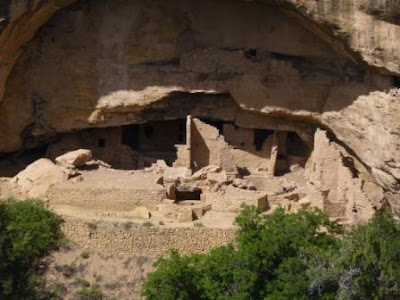Dusk in the campground, with a full moon. Temperatures had cooled and Smoke and I were out for a little red dirt troll and roll.
Ok, it's 3 hours from our campsite, but it's waaaay further from Virginia! So, we took the day, left dawn-ish, and headed south to Mesa Verde. Mesa Verde is Spanish for green table. It is!
Unfortunately, in 2002, a lightening strike caused a forest fire, about 2000 burned acres. The lightening can strike a pinion pine tree. The tree just smolders for a day or so and then, when the humidity drops to single digits, it bursts into flames, creating the forest fire. 10 years ago and still no real natural reclamation. That will take about 300 years.
The site give you a look into the lives of the Ancestral Pueblo people who lived here for over 700 years, from A.D. 600 to 1300 A.D. The park protects over 4000 known archaeological sites, including 600 cliff dwellings. By 1300 A.D., over 40,000 Ancestral Pueblo people lived in this area. That is more than live here today!
The cliff dwellings were our goal. And we were not disappointed! The cliff dwellings were discovered only in 1888. First view, from overlooks above, looking at Cliff Palace. This is the "crown jewel" of the Mesa Verde park, filled with rooms, plazas, worship Kivas, and towers that are 3 stories high.
WOW, huh??!!! As we descended (Ranger Peter lead our group - you can't do this alone!) the view got better.
Ground view from one side, complete with tourist group.
Other side, without tourists.
Here is view from the floor of the dwelling.
Leaving, we climb up old stone steps through a narrow rock pass.That is not MY butt...
Then up a steep wooden ladder - that's Luke.
From the Cliff Palace, we scooted over to the Balcony House. There we had a 35 foot ladder to get INTO the cliff dwelling. Here is the ranger, giving us "Ladder 101".
The Balcony House is a much smaller dwelling. This was probably used for ceremonial rituals as well as storage of food. There is lots of evidence of turkey pens in the dwellings. The Puebloans were farmers who grew their crops on the tops of the mesas. But they lived and stored their food in the cliff dwellings. Want water for cooking or masonry? 650 ft down, using hand and toe notches in the rocks. Think about bringing it back up in baskets... Want to farm? Same thing, only upwards to start. The average life expectancy was in the late 20's.
This particular dwelling had great security. Only way in was through a series of narrow tunnels. You can see OUT of the tunnels from the inside but you can't see IN from the outside. The only way out for us was through the 18" wide and 24" high "tunnel". I almost didn't do the tour. You can see the hole for the tunnel in the back of the dwelling. It was 12 ft long, but you could sort of stand up in the center part. We were ok, but I did go third, following a bigger fellow through - no waiting and stressing for me!
Eventually, the Puebloans moved from the cliff dwellings to houses build in the mesas. These Pithouses were just that - the room was built into the earth, anywhere from a foot to 8 feet. Roofs were just high enough to allow the inhabitants to sit upright in the lower Pithouses. Ingenious for their time, they knew that they needed ventilation. But a hole from the ground directly into the house would blow too hard and extinguish the small fire inside. So, each Pithouse has a stone barricade between the opening from the ventilation hole and the fire.
Then, suddenly, they left. Today's ancestors will tell you that the sky told them that "it was time". Perhaps it was also the 23 year drought combined with an ice age in 1300. They did leave, but did not vanish. Evidence says they went to Hopi, Zuni, Acoma, and Laguna villages.
There are a lot of other cliff dwellings that you can see from the canyon rim. Most are not accessible to the public.
Coming home, it was a dark night, and in a country side that never sleeps, (sorry, Guy) a big rock had rolled into the passing lane, about 35 miles from our campsite. Yes, with a loud bang, we hit it, but fortunately, a rest area was immediately at hand. Reading the directions in the manual, Luke and I changed the tire (mostly Luke...). We got another tire today, and we are good to go. Not much fun changing a tire at 10 pm in a dark rest area but we got it done!
Today we saw Needles in Caynonlands National Park. I'll try to post tomorrow. Tomorrow we'll leave early and see Arches National Park, if all goes to plan.
















No comments:
Post a Comment